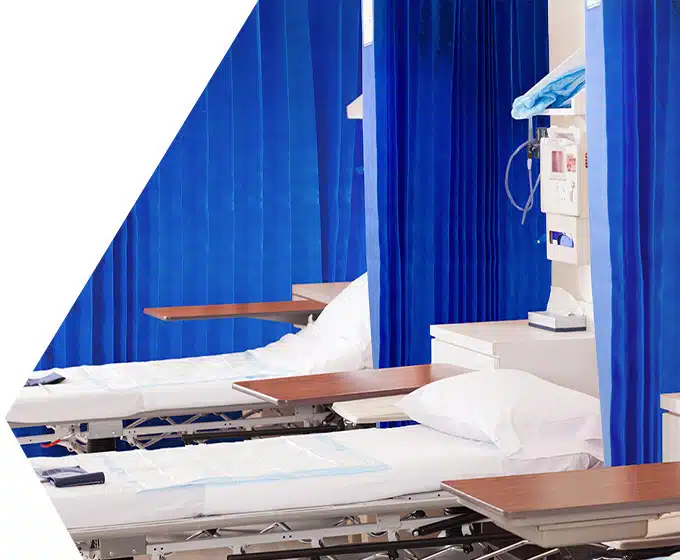Understanding the Resin Identification Code System and Recycling Polypropylene Disposable Curtains in Hospitals
In the medical field, the use of disposable materials is essential for maintaining hygiene and preventing infection. One such material is polypropylene, as used in our Endurocide® Disposable Hospital Curtain range.
Most common types of plastics used in consumer products and packaging are covered by a Resin Identification Code (RIC) system. Understanding the RIC system, the safety and categorisation of polypropylene, and the process for its disposal and recycling is crucial for hospital professionals. This article delves into these topics, providing a quick guide to help support environmentally responsible practices in hospitals.
What is the Resin Identification Code (RIC) system?
The RIC system was developed in 1988 by the Society of the Plastics Industry to facilitate the recycling of post-consumer plastics. The system uses a set of symbols, usually a number within a triangle of arrows, to identify the type of plastic resin used in a product. This helps recycling facilities sort plastics more efficiently.
The codes range from 1 to 7:
- PET (Polyethylene Terephthalate)
- HDPE (High-Density Polyethylene)
- PVC (Polyvinyl Chloride)
- LDPE (Low-Density Polyethylene)
- PP (Polypropylene)
- PS (Polystyrene)
- Other (Various other plastics)
Polypropylene (PP) and its use in Hospital Disposable Curtains
Endurocide® Curtains are made of 100% polypropylene material. Polypropylene, marked with the number 5 in the RIC system, is a versatile plastic known for its strength and durability. It is also non-reactive and doesn’t release harmful chemicals making it ideal for medical settings. These properties make it an ideal material to use in our Endurocide® Curtains, which are used in high-touch areas, over extended periods of time.
Disposing & recycling of polypropylene disposable curtains
When polypropylene hospital curtains reach the end of their useful life, proper disposal and recycling become essential. Some of the ways hospitals can generally manage this process include:
1. Segregation and collection: Hospitals should have a clear protocol for collecting used curtains, which will need to be segregated from other medical waste to ensure they can be recycled.
2. Contamination procedures: Used curtains may be contaminated with biological materials. Please ensure you follow your individual hospital’s or recycling centre’s protocols around the recycling of medical waste.
3. Disposal streams: In general, hospitals can follow one of the following three disposal streams:
a) Second-life products
If hospital protocols allow, the curtains can be fully recycled. Polypropylene is a versatile material that recycling facilities can break down into its base resin to be reused in new products. For example, some customers have turned used curtains into plastic fences.
Polypropylene recycling processes involve heating and melting, which should destroy all potential pathogens on the curtains. However, always check with your local recycling facility for more information on what they will accept and what they could turn your curtains into.
b) Incineration
Should hospital protocols not allow the recycling of curtains that have come into contact with pathogens or bodily fluids, curtains can be incinerated in a waste-to-heat facility, or a hospital incinerator. Polypropylene has a high calorific value, and one full-width curtain could potentially generate enough energy to light a standard light bulb for an hour and a half.
c) Hospital Waste
If hospital procedures do not permit the recycling of curtains and the hospital doesn’t have the ability to incinerate curtains, Endurocide® Curtains can be disposed of as standard hospital waste in accordance with local protocols.
Considerations for hospitals
Hospitals play a vital role in ensuring the successful recycling of polypropylene curtains. Here are some key considerations:
1. Education and training: Staff should be educated about the importance of proper disposal and recycling procedures. Training programs can help ensure everyone understands how to segregate and prepare materials for recycling.
2. Partnerships with recycling facilities: Establish partnerships with local recycling facilities that can handle polypropylene. Some facilities can offer dedicated bins and regular collection services for hospitals recycling their curtains.
3. Sustainable practices: Implementing a hospital-wide sustainability program can help reduce overall waste and promote recycling efforts. Regular audits and reviews can help identify areas for improvement.
4. Regulatory compliance: Ensure compliance with local regulations regarding the disposal and recycling of medical waste. This may include specific guidelines for handling and processing polypropylene materials.
5. Choose the correct product: Ensure your curtain is designed for extended use and has proven efficacy against a broad spectrum of pathogens. Selecting a product like Endurocide® Antimicrobial Plus Curtains, which have been tested and shown to be effective for up to 2 years after installation, reduces the need for frequent replacements.
Conclusion
Polypropylene disposable curtains are a safe and effective choice for hospitals, providing essential benefits in maintaining hygiene and infection control.
By understanding the RIC system and following proper disposal and recycling protocols, hospitals can significantly reduce their environmental impact. Educating staff, partnering with recycling facilities, and adhering to regulatory guidelines are crucial steps in this process. Through these efforts, hospitals can contribute to a more sustainable future while making responsible choices that benefit both their patients and the environment.
| If you would like to discuss the use and disposal of any of your Endurocide® Curtains, please contact us: |





